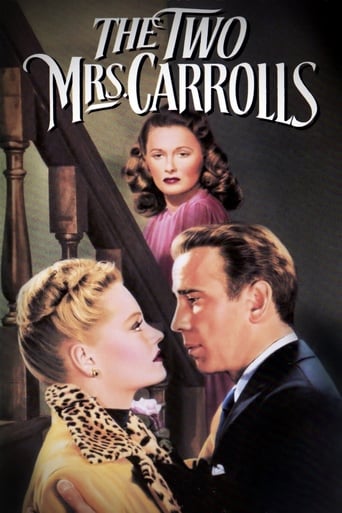Edgar Allan Pooh
. . . was a famous British painter, some if not most Art Historians have come to believe that many of the Old Masters were serial killers of their nude models on the side. (As Julia Child says, "You cannot make a great omelet without cracking a good many eggs.") Art Lovers lament that there don't seem to be many Da Vincis and Michaelangelos splashing paint on canvas nowadays. THE TWO MRS. CARROLLS shows us that the REAL problem is that Society has gotten too squeamish about "cracking eggs" in a good cause, and all the CSI's running around totally curtail Artistic Freedom. God told Saint Joan (in one of His mysterious ways) to have a child predator with scores of kills as lead general of her army. Adolph Hitler and John Wayne Gacy are among a plethora of later historical figures who were frustrated painters at heart. Artist Geoffrey Carroll (Humphrey Bogart) runs into all kinds of resistance and red tape before he even can get to the would-be third Mrs. Carroll. Only Geoffrey's young daughter "Bea" turns out to be a true Art Lover here. The bottom line is that THE TWO MRS. CARROLLS relates why today's world is unlikely to enjoy a new Mona Lisa.
demelza3000
Others have described this movie pretty well, so I just wanted to add a few thoughts. This is a suspense drama released in 1947 starring Humphrey Bogart and Barbara Stanwyck. The plot and actors are OK, but I thought the big winner here was Edith Head. Her gowns and even the lounge wear is stunning in this movie. There is an attempt to portray the good girl in white and the bad girl (Alexis Smith) in black. Hats off to the hair and lighting guys too, Barbara Stanwyck is beautiful throughout. Bogarts' sudden headaches get ridiculous after awhile. The plot point I had the most trouble with is that the daughter only seems to go to school when dad needs to off a wife, yet she talks like a Rhodes Scholar. This movie will hold your attention, it just doesn't completely satisfy.
JohnHowardReid
Although credits are top-draw, production values are very moderate. Peter Godfrey's direction is also a mite disappointing. Neither he nor screenplay writer Thomas Job have made much attempt to open up the stage play. Instant information dialogue is put across with a disconcerting lack of subtlety in both writing and delivery. Ann Carter's unrealistically precocious child and Nigel Bruce's blustering, stereotyped doctor are the worst offenders. Bogart himself delivers another of his very capable studies in psychopathology. Barbara Stanwyck is also cast strictly to type, but she too comes across effectively. Both she and Bogart give seemingly effortless portrayals as they both have parts they can play standing on their heads. Alexis Smith makes a strong impression in an unsympathetic part. On the other hand, Patrick O'Moore makes a wet, colorless hero. In the support cast, Anita Bolster (looking rather like Margaret Hamilton) gives an audience-pleasing portrait of a cynical servant. Godfrey himself does a brief and amusing cameo as a race-track con man. Barry Bernard registers as the blackmailing Blagdon, while Isobel Elsom delivers her usual capable rendition of a high society lady. Godfrey's direction is at its best in the climax with the camera tracking across the room with Bogart as he makes his preparations. It must be admitted that Godfrey sees the action from a cinematic rather than a stage audiences' point-of-view, but his approach is often unimaginatively routine. All the same, certain sequences do have power (the murder, the climax, the discovery of the portrait), but thanks as much to deft film editing and atmospheric photography by Peverell Marley (who lights Miss Stanwyck most attractively) as anything else. Stanwyck is also most attractively costumed and made up. Alert music scoring effectively mirrors every cue in the dialogue.
evening1
I had seen this years ago, and remembered it as scary, but this time around it seemed obvious.Humphrey Bogart overacts as a mentally disturbed, conniving, serial-marrying artist who's being blackmailed by his druggist. How could Bogie have accepted a hack role like this only five years after the sublime "Casablanca"? This 1947 film has an overdone soundtrack that triple-underlines every dramatic moment, as if the viewer is a dunce. Barbara Stanwyck's performance seems less exaggerated than some of her peers', and the icily beautiful Alexis Smith does well as a predatory blonde. Perhaps as is typical of movies of the era, the child actor in the film seems almost eerily mature -- a woman stuffed into a girl's body. (When I looked Ann Carter up on Wikipedia I learned that "in her best roles, she is a vulnerable child trapped in a hostile adult world.") This film has intermittent interest but hasn't aged well.



